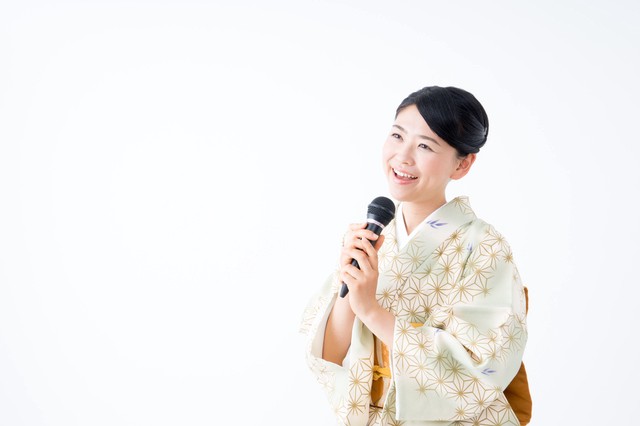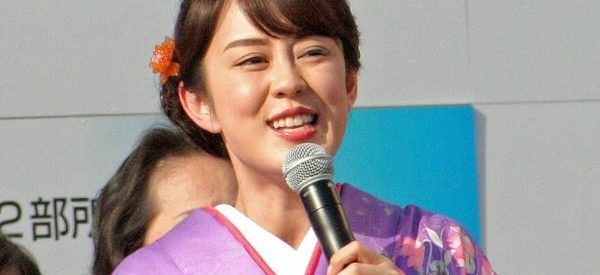
By Alyssa Pearl Fusek
If you?ve explored the Japanese music scene, you?ve inevitably come across enka music. Maybe you?ve heard people snort in derision and call enka ?old people music.?
Often performed to a mixture of Western and Japanese instruments, and with singers in traditional Japanese attire, enka (??), Japan?s folk music, hearkens back to an idealized view of Japan prior to modernity and a perceived degradation in tradition. With its focus on lost love, nostalgia, death, and other similar melancholy themes, enka lyrics are highly emotional. Singers of enka employ a technique called kobushi (??), where a single syllable of a word is sung while moving through different notes. The singer?s pitch varies with this movement, adding a ululating effect not dissimilar from the technique used in vibrato.
Derived from the term enzetsu no uta (????) meaning ?speech song,? enka didn?t start off as sentimental. Its aesthetic changed with the turbulent pre- and post-war eras before evolving in its current emotionally charged form. Labeled by some as ?the heart of Japan? (????), enka music is notable for its ululating notes wavering somewhere between nostalgia and determination.
Make Music Not War: The Freedom and Civil Rights Movement
1868 saw witness to the overthrow of the shogunate and the establishment of the Meiji government. Yet despite its modern undertones, the new government was still led by powerful samurai from the Satsuma and Choshu domains. Not even five years after the Meiji Restoration, whispers of unrest eventually culminated in the formation of the Freedom and Civil Rights Movement (??????; Jiy? minken und?), or Jiy?to for short (???).
Spearheaded by disgruntled farmers, factory workers, and urban intellectuals, the movement demanded a more democratic approach to how the government was run. Their list of demands included a reduction in land taxes, an amendment to the numerous Unequal Treaties (????; Fuby?d? j?) brooked between Japan and various Western countries, institution of a national assembly, and a constitution that protected basic civil rights.
(JP) Link: Understanding the Freedom and Civil Rights Movement in 5 Minutes!
5??????????????????????????
????????????????????????????????????????????????????????????????????????????????????????????????????? …
honcierge.jp
At the time, the Meiji government had banned dissident speeches and protests about the new regime. So the Jiyuto had to get creative in order to make their voices heard. Rather than use force, they found a roundabout way to make political speeches without breaking the ban: singing.
Enter Soeda Azenbo (?????). Rising from the depths of day laborer life to become one of the most well-known ballad composers, he wrote songs about the government and society couched in satire and humor. These political activist songs merited their own sub-genre: soshi enka (????). His memoir A Life Adrift (???; Ryusei-ki) remains one of the most thorough and insightful accounts of life for a prewar enka singer.
 Soeda Azenbo (1872?1944) photographed in 1920. Despite his impact on the enka scene, he eventually faded into obscurity as his leftist activities faced criticism in a country preparing for war. (Picture: Wikipedia Japan)
Soeda Azenbo (1872?1944) photographed in 1920. Despite his impact on the enka scene, he eventually faded into obscurity as his leftist activities faced criticism in a country preparing for war. (Picture: Wikipedia Japan)
Enka nowadays utilizes a variety of musical instruments, but in Soeda?s day, many street corner bards, or enka-shi (???) relied solely on their voices. Eventually enka-shi printed their song lyrics and distributed them as they were singing, which inevitably caught the government?s attention. The Jiyuto achieved some of their demands when the government established a national assembly, but many activists eventually abandoned the pacifist speech songs in favor of outright rebellion, and the movement eventually splintered into different organizations. Enka stayed and proved to be a more steadfast fixture in Japanese culture than its political origins.
Enka in the Taisho and Showa Eras
During the Taisho era (1912?1926), more instruments began to be introduced as accompaniments in enka music, and it moved away from its street-corner origins to the emerging music studios. Musicians and composers began to draw inspiration from jazz and Hawaiian music. In the rising wave of modernity, enka also gradually lost its political affiliations. A narrative style of music called r?kyoku (??) also sprang up, similar to the satirical stories old enka-shi used to sing or chant.
In the Showa era (1926?1989), enka eventually faded into the background in the late 20s as kay?kyoku (???; pop music) flourished. As music genres are incredibly fluid and rarely stationary, many songs considered ?popular? gradually merged with the enka genre. Postwar Japan brought a huge shift to the music scene. Many rokyoku singers shifted to singing enka songs, as enka was considered ?lyrically shorter? than the long meandering songs of the rokyoku style.
Much like artists in the American blues scene, many enka aficionados struggled to profit off their music and ended up becoming one-hit wonders. However, some managed to establish themselves as dominant in the enka scene. Misora Hibari (?? ???) is one such household name. A prodigy at the age of 12, her first single ?Kappa Boogie-Woogie (??????, Kappa bugi ugi) exploded the music charts and ensured her career as a singer. She is often known as the ?Queen of Enka.?
Misora Hibari singing one of her most popular songs, ?????????? ( Kawa no nagare no yoni). This was her last recorded single before her death in 1989; many musicians today sing this song as tribute.
The rise of ?modern? enka is said to occur in the late 50s as Japan struggled to reconstruct after their defeat in World War II. Enka became favorable for its retrospective look on old values and beliefs that were facing scrutiny in a frayed society. Enka can be considered a ?conservative? style of music.Female enka singers often perform in traditional Japanese kimono; male enka singers also deck out in formal wear. Famed enka singer Itsuki Hiroshi (?????), once dubbed ?Japan?s Frank Sinatra? would usually perform decked out in handsomely tailored suits and tuxedos. The refined appearance and graceful gestures of enka singers is at complete odds with flamboyant, hardcore visual kei bands, yet just as compelling.
Enka Today
 Popular enka singer Oka Midori performing in public. (Source: Wikipedia)
Popular enka singer Oka Midori performing in public. (Source: Wikipedia)
As Japanese aidoru pop began topping the music charts in the 90s, enka gradually declined in popularity. In 2016, the government established the ?Parliamentarians Supporting Enka and Kayokyoku Committee? (?????????????????; Enka kay?kyoku o ?en suru kokkai giin no kai) to promote the ?disappearing traditions? of enka and its parent style kayokyoku.
(JP) Link: How Long Will Enka Remain ?The Spirit of Japan?? The Moment Enka Became the Symbol of Tradition
??????????????? ??????????????? – withnews?????????
????????????????????????????????????????????????????????????????????1960?????????????????????????????????????????????????
withnews.jp
Numerous enka singers who began their careers in the late Showa era are still active in the music scene. Relatively younger enka singers like Hikawa Kiyoshi (?? ???), aka the ?Prince of Enka? and Yamauchi Keisuke (????) draw in large numbers of female fans ? and therefore sales ? with their charm and good looks. During NHK?s annual year-end music contest ?K?haku Uta Gassen? (?????), there?s always an enka singer or two competing. Enka has also found its way overseas: American singer Jerome ?Jero? White is regarded as Japan?s first black enka singer, taking inspiration from his Japanese grandmother and her old enka records.
While enka certainly appeals to older generations, I don?t believe the enka scene will truly die out. Nostalgia for a different past (and better, for some) isn?t a trend that easily goes away. In enka there?s something virtually anyone can relate to ? a night out drinking, watching the sunrise, missing an unrequited love. Those types of experiences are eternal, even if the style in which they?re sung has faded with time.
If you want to check out some more of enka?s greatest hits, be sure to check out this curated list of some of Japan?s best-selling enka songs.
Sources
Lewis, Michael (Translator), Soeda, Azenbo. A Life Adrift: Soeda Azembo, Popular Song and Modern Mass Culture in Japan. Routledge, 2009.
Martin, Alex. ??Enka? still strikes nostalgic nerve.? The Japan Times, Nov 18 2008. https://www.japantimes.co.jp/news/2008/11/18/reference/enka-still-strikes-nostalgic-nerve/#.XXWfsmZ7nIU
Alyssa Pearl Fusek is a freelance Japan and mental health content writer living in Chico, California with her partner and one cat. She graduated in 2015 from Willamette University with a B.A. in Japanese Studies and continues to improve her Japanese language skills. She is also a published poet and fiction writer. You can check out her freelance writing work at The Japanese Pearl.
Originally published at https://unseenjapan.com on September 17, 2019.


